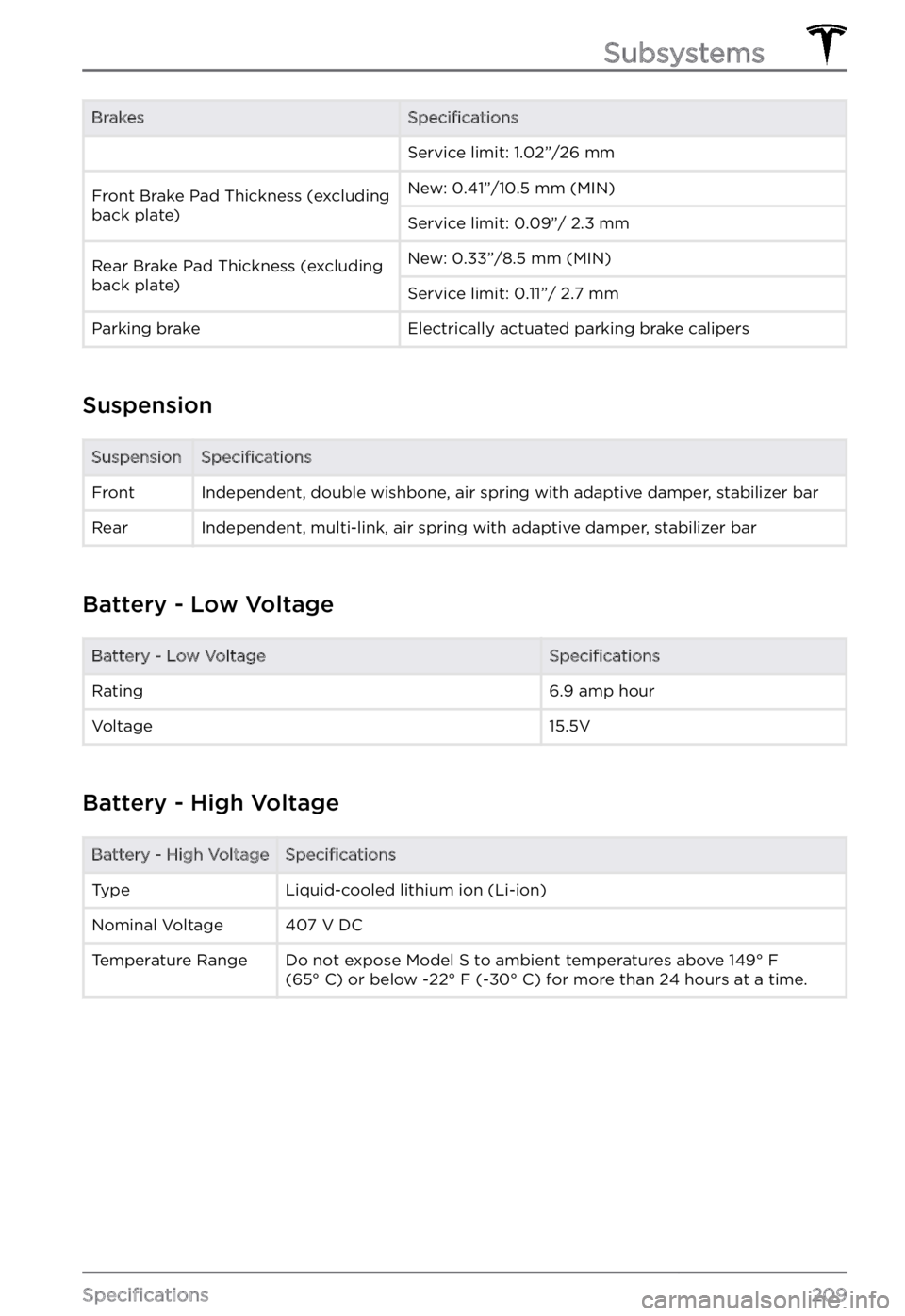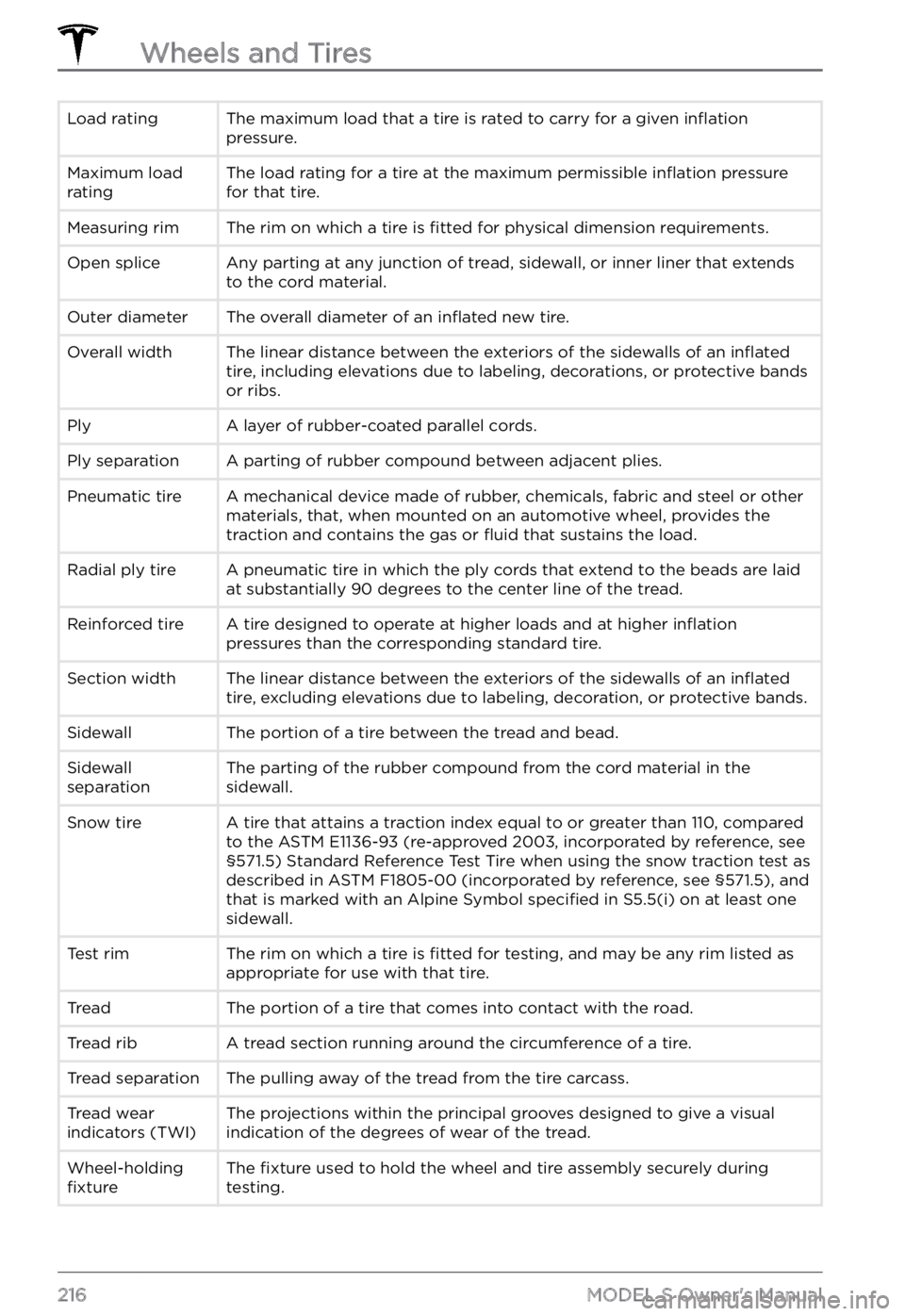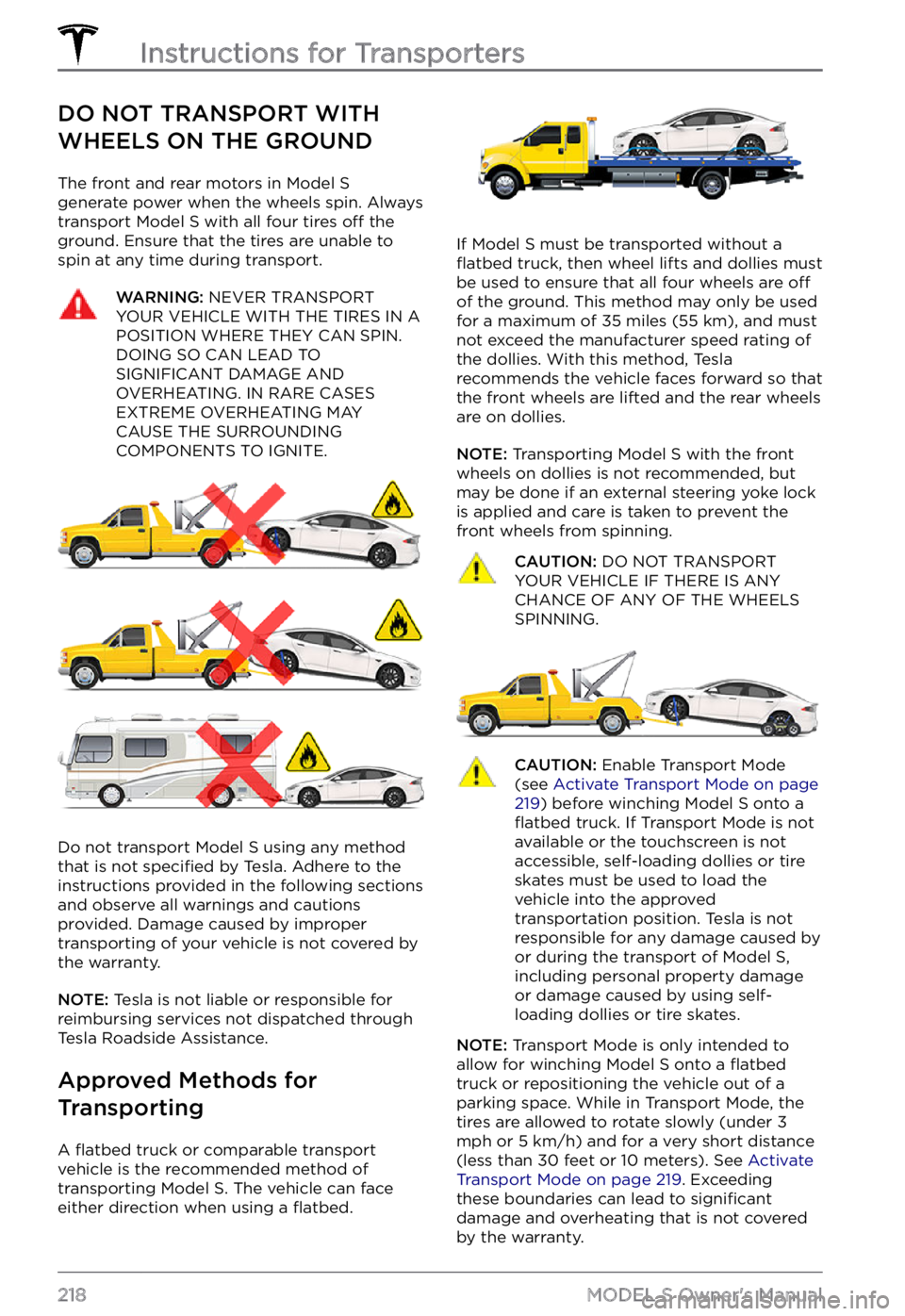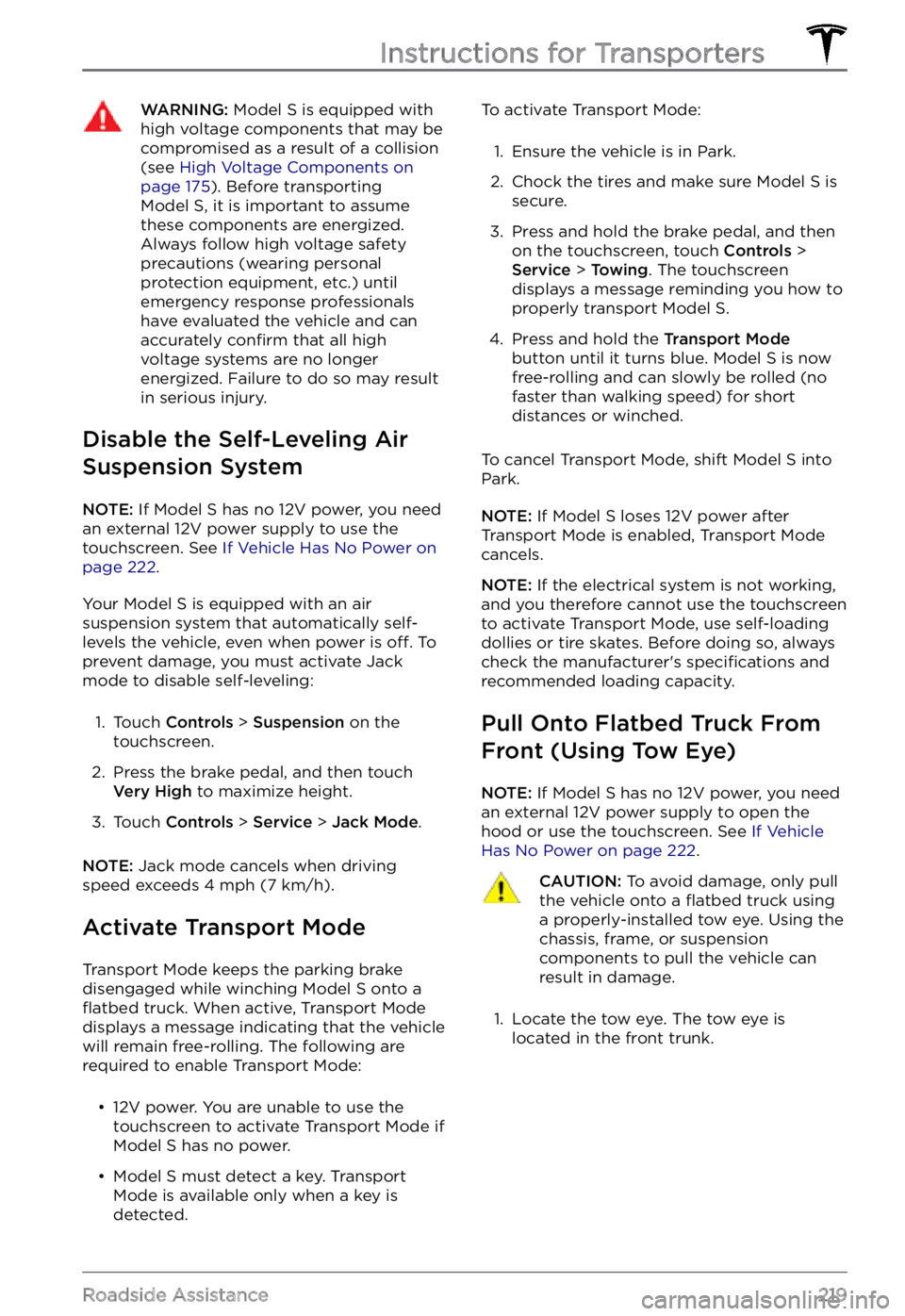ESP TESLA MODEL S 2022 Owner´s Manual
[x] Cancel search | Manufacturer: TESLA, Model Year: 2022, Model line: MODEL S, Model: TESLA MODEL S 2022Pages: 281, PDF Size: 7.63 MB
Page 204 of 281

Parts, Accessories, and
Modifications
Use only genuine Tesla parts and accessories.
Tesla performs rigorous testing on parts to
ensure their suitability, safety, and reliability.
Purchase these parts from Tesla, where they
are professionally installed and where you can
receive expert advice about
modifications to Model S. Accessories are available for
purchase from Tesla stores or online at
www.tesla.com.
NOTE: Some accessories may not be available
in your market region.
Tesla is unable to assess parts manufactured
by other distributors and therefore accepts
no responsibility if you use non-Tesla parts on
Model S.
WARNING: Installing non-approved parts and accessories, or performing non-approved modifications, can affect the performance of Model S and the safety of its occupants. Any damage caused by using or installing non-approved parts, or by performing non-approved modifications, is not covered by the warranty.
WARNING: Tesla does not accept liability for death, personal injury or damage that occurs if you use or install non-approved accessories or make non-approved modifications.
Body Repairs
If your Model S is in a collision, contact Tesla
or a Tesla-approved Body Shop to ensure that
it is repaired with genuine Tesla parts. Tesla
has selected and approved body shops that
meet strict requirements for training,
equipment, quality, and customer satisfaction.
Some repair shops and insurance companies
might suggest using non-original equipment
or salvaged parts to save money. However,
these parts do not meet Tesla
Page 211 of 281

BrakesSpecificationsService limit: 1.02”/26 mmFront Brake Pad Thickness (excluding
back plate)New: 0.41”/10.5 mm (MIN)Service limit: 0.09”/ 2.3 mmRear Brake Pad Thickness (excluding
back plate)New: 0.33”/8.5 mm (MIN)Service limit: 0.11”/ 2.7 mmParking brakeElectrically actuated parking brake calipers
Suspension
SuspensionSpecificationsFrontIndependent, double wishbone, air spring with adaptive damper, stabilizer barRearIndependent, multi-link, air spring with adaptive damper, stabilizer bar
Battery - Low Voltage
Battery - Low VoltageSpecificationsRating6.9 amp hourVoltage15.5V
Battery - High Voltage
Battery - High VoltageSpecificationsTypeLiquid-cooled lithium ion (Li-ion)Nominal Voltage407 V DCTemperature RangeDo not expose Model S to ambient temperatures above 149
Page 218 of 281

Load ratingThe maximum load that a tire is rated to carry for a given inflation pressure.Maximum load
ratingThe load rating for a tire at the maximum permissible inflation pressure
for that tire.Measuring rimThe rim on which a tire is fitted for physical dimension requirements.Open spliceAny parting at any junction of tread, sidewall, or inner liner that extends
to the cord material.Outer diameterThe overall diameter of an inflated new tire.Overall widthThe linear distance between the exteriors of the sidewalls of an inflated tire, including elevations due to labeling, decorations, or protective bands
or ribs.PlyA layer of rubber-coated parallel cords.Ply separationA parting of rubber compound between adjacent plies.Pneumatic tireA mechanical device made of rubber, chemicals, fabric and steel or other
materials, that, when mounted on an automotive wheel, provides the
traction and contains the gas or
fluid that sustains the load.
Radial ply tireA pneumatic tire in which the ply cords that extend to the beads are laid
at substantially 90 degrees to the center line of the tread.Reinforced tireA tire designed to operate at higher loads and at higher inflation pressures than the corresponding standard tire.Section widthThe linear distance between the exteriors of the sidewalls of an inflated tire, excluding elevations due to labeling, decoration, or protective bands.SidewallThe portion of a tire between the tread and bead.Sidewall
separationThe parting of the rubber compound from the cord material in the
sidewall.Snow tireA tire that attains a traction index equal to or greater than 110, compared
to the ASTM E1136-93 (re-approved 2003, incorporated by reference, see
Page 220 of 281

DO NOT TRANSPORT WITH
WHEELS ON THE GROUND
The front and rear motors in Model S generate power when the wheels spin. Always
transport Model S with all four tires off the
ground. Ensure that the tires are unable to
spin at any time during transport.
WARNING: NEVER TRANSPORT YOUR VEHICLE WITH THE TIRES IN A POSITION WHERE THEY CAN SPIN. DOING SO CAN LEAD TO SIGNIFICANT DAMAGE AND OVERHEATING. IN RARE CASES EXTREME OVERHEATING MAY CAUSE THE SURROUNDING COMPONENTS TO IGNITE.
Do not transport Model S using any method
that is not specified by Tesla. Adhere to the
instructions provided in the following sections
and observe all warnings and cautions provided. Damage caused by improper transporting of your vehicle is not covered by
the warranty.
NOTE: Tesla is not liable or responsible for
reimbursing services not dispatched through
Tesla Roadside Assistance.
Approved Methods for
Transporting
A flatbed truck or comparable transport
vehicle is the recommended method of
transporting
Model S. The vehicle can face
either direction when using a flatbed.
If Model S must be transported without a flatbed truck, then wheel lifts and dollies must
be used to ensure that all four wheels are off
of the ground. This method may only be used
for a maximum of 35 miles (55 km), and must
not exceed the manufacturer speed rating of
the dollies. With this method, Tesla
recommends the vehicle faces forward so that
the front wheels are lifted and the rear wheels
are on dollies.
NOTE: Transporting Model S with the front
wheels on dollies is not recommended, but
may be done if an external
steering yoke lock
is applied and care is taken to prevent the
front wheels from spinning.
CAUTION: DO NOT TRANSPORT YOUR VEHICLE IF THERE IS ANY CHANCE OF ANY OF THE WHEELS SPINNING.
CAUTION: Enable Transport Mode (see Activate Transport Mode on page 219) before winching Model S onto a flatbed truck. If Transport Mode is not available or the touchscreen is not accessible, self-loading dollies or tire skates must be used to load the vehicle into the approved transportation position. Tesla is not responsible for any damage caused by or during the transport of Model S, including personal property damage or damage caused by using self-loading dollies or tire skates.
NOTE: Transport Mode is only intended to
allow for winching Model S onto a flatbed truck or repositioning the vehicle out of a
parking space. While in Transport Mode, the
tires are allowed to rotate slowly (under
3 mph or 5 km/h) and for a very short distance
(less than 30 feet or 10 meters). See Activate Transport Mode on page 219. Exceeding
these boundaries can lead to significant
damage and overheating that is not covered
by the warranty.
Instructions for Transporters
218MODEL S Owner
Page 221 of 281

WARNING: Model S is equipped with high voltage components that may be compromised as a result of a collision (see High Voltage Components on page 175). Before transporting Model S, it is important to assume these components are energized. Always follow high voltage safety precautions (wearing personal protection equipment, etc.) until emergency response professionals have evaluated the vehicle and can accurately confirm that all high voltage systems are no longer energized. Failure to do so may result in serious injury.
Disable the Self-Leveling Air
Suspension System
NOTE: If Model S has no 12V power, you need
an external 12V power supply to use the
touchscreen. See
If Vehicle Has No Power on page 222.
Your Model S is equipped with an air
suspension system that automatically self-
levels the vehicle, even when power is
off. To
prevent damage, you must activate Jack mode to disable self-leveling:
1.
Touch Controls > Suspension on the
touchscreen.
2.
Press the brake pedal, and then touch Very High to maximize height.
3.
Touch Controls > Service > Jack Mode.
NOTE: Jack mode cancels when driving
speed exceeds 4 mph (7 km/h).
Activate Transport Mode
Transport Mode keeps the parking brake
disengaged while winching Model S onto a flatbed truck. When active, Transport Mode
displays a message indicating that the vehicle
will remain free-rolling. The following are
required to enable Transport Mode:
Page 227 of 281

All other trademarks contained in this
document are the property of their respective owners and their use herein does not imply sponsorship or endorsement of their products
or services. The unauthorized use of any trademark displayed in this document or on the vehicle is strictly prohibited.
About this Owner Information
225Consumer Information
Page 237 of 281

See Drive to Calibrate Cameras on page 85 for more information.
When calibration is complete, Traffic-Aware Cruise Control and Autosteer should be available.
If the alert persists and camera calibration has not completed after your vehicle has driven 100
miles (160 km) or more, or Traffic-Aware Cruise Control and Autosteer remain unavailable
despite successful camera calibration, schedule service at your earliest convenience. Your
vehicle is OK to drive in the meantime.
(APP_w304)
Camera blocked or blinded
Clean camera or wait for it to regain visibility
One or more of the vehicle cameras is blocked or blinded due to external conditions. When the cameras cannot provide accurate visual information, some or all Autopilot features may be
temporarily unavailable.
Cameras can be blocked or blinded due to many factors, including: